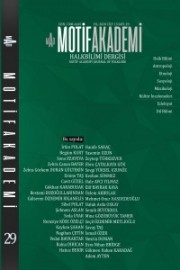GELENEKSEL KUMAŞ ÖRNEKLERİNDEN AĞABANİ/ABANİ/AĞBANİ
TRADITIONAL FABRIC SAMPLES: AGABANI/ABANI/AGBANI
Author(s): Ebru Çatalkaya GökSubject(s): Visual Arts, Recent History (1900 till today), International relations/trade, Sociology of Culture
Published by: Motif Halk Oyunları Eğitim ve Öğretim Vakfı
Keywords: Abani; agabani; agbani; traditional fabric; fabric analysis;
Summary/Abstract: Traditional fabrics are getting more important according to their datedness, raw material and the quality of workmanship. Abani, which is defined as a fabric embroidered with yellow silk on white background in written and visual sources, is one of the important weaving examples. In historical times, this type of fabric, known to the public as turban, was used by traders to distinguish it from the Ulema class. In historical times, this type of fabric was known to the public as a imamah and was used by traders to distinguish it from the Ulema class. The imitations of this fabric, which is of Indian origin, started to be woven in Bursa over time. It is seen in the documents that this fabric continued to be woven on hand looms in the beginning of XX century, despite the semi-automatic looms. Today, it is no longer produced. The purpose of the study is to create identification information so that abani fabrics can be weaved again. The fabrics are produced with two techniques. For this reason, the universe of the study is abani fabrics, the sample is determined as abani fabrics produced by weaving technique. Detailed information is given on the yarn, technical and motif features of the fabric samples that can be reached. The study consists of four parts. In the first part; the origin of the word abani is emphasized and its historical development is discussed. In the second part; Definitions of the word abani in written sources are emphasized. In the third part; Information about motif, composition and technical properties of abani fabrics and their usage areas are given. In the fourth part; The study is evaluated in its entirety and completed by the conclusion.
Journal: Motif Akademi Halkbilimi Dergisi
- Issue Year: 13/2020
- Issue No: 29
- Page Range: 294-307
- Page Count: 14
- Language: Turkish

